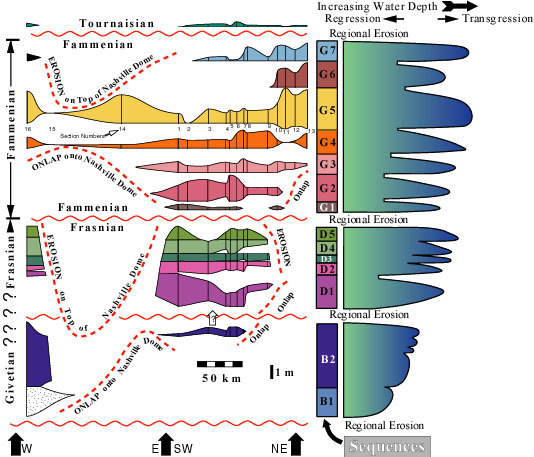
 |
|
|
|
|
|
|
| The Late Devonian Chattanooga Shale of Tennessee and Kentucky is
in most areas a thin black shale deposit of less than 10 meters
thickness. It is a distal equivalent to the almost 3000m thick
Catskill sequence, and encompasses most of the Frasnian and
Fammenian, approximately 14 million years of earth history. Although originally thought of as a continuously, though slowly, deposited deep water shale unit, the Chattanooga Shale shows internal erosion surfaces at various scales as well as storm deposits. These features suggest comparatively shallow water deposition (tens of meters water depth), and a stratigraphic record with numerous interruptions of various duration. A number of erosion surfaces are laterally extensive and can be traced from exposure to exposure through the entire outcrop area (over distances of as much as 300km). Erosion surfaces of this type are considered sequence boundaries sensu Vail, and tracing them has made it possible to subdivide the Chattanooga Shale into as many as 14 sequences. These sequence boundaries are very subtle features (see Table). The following features are indicative of their presence in a given outcrop: 1) sandy, silty, or pyritic lag deposits of up to several cm thickness; 2) sharp-based shale beds; 3) low-angle truncation of shale beds; 4) scoured surfaces; and 5) soft-sediment deformation in underlying shales. Tracing erosion surfaces from outcrop to outcrop is based on a combination of: 1) petrographic matching of lag deposits; 2) the petrography and microfabrics of individual shale packages; 3) conodont data; and 4) gamma ray surveys. Collection of further conodont data and extension of this stratigraphic framework to adjacent areas may eventually lead to a comprehensive stratigraphic framework for the entire Late Devonian black shale complex of the eastern US. Comparison between distal and proximal successions may allow differentiation of truly eustatic events from those due to tectonism and sedimentation. |
 Overview
of Sequence Stratigraphy along the southern and eastern Highland Rim
of central Tennessee. The sequences are based on tracing of erosion
surfaces by the means outlined above. Overview
of Sequence Stratigraphy along the southern and eastern Highland Rim
of central Tennessee. The sequences are based on tracing of erosion
surfaces by the means outlined above.Sequence developement reflects the combined influences of sea level variations and the topography of the Nashville Dome. Geometry of "sequence slices" is likely to change as more data (conodont work) become available, the overall stratigraphic subdivision, however, is likely to remain the same. The lowermost, probably mostly Givetian
package, is only found in isolated areas in Tennessee. The middle
package, of Frasnian age, is represented by the Dowelltown Member,
whereas the uppermost, Fammenian, package is known as the Gassaway
member. The presence of Givetian to early Frasnian deposits at the
base of the section was not known previously, but is indicated on
lithologic and paleontologic (conodonts) grounds. This lower portion
is apparently an equivalent of the Blocher Formation as known in
Kentucky and Indiana. Work on better age characterization of these
basal deposits is in progress. |
| Overview Publication: Schieber, J., 2004, Connecting the dots: Sequence stratigraphic correlations in Devonian black shales of the eastern US and relationship to global sea-level variations. In: Devonian Black Shales of the Eastern U.S.: New Insights into Sedimentology and Stratigraphy from the Subsurface and Outcrops in the Illinois and Appalachian Basins. Field Guide for the 2004 Great Lakes Section SEPM Annual Field Conference, J. Schieber and O.R. Lazar (eds.), Indiana Geological Survey Open File Study 04-05, p. 80-82. download PDF file (left click on link and click on "Save as"...) |
|
|
| Back to SHALE RESEARCH LAB Main Page |
| Back to IU Department of Geological Sciences |
|
© Jürgen Schieber, IU Bloomington Department of
Geosciences |